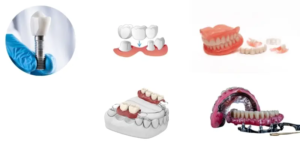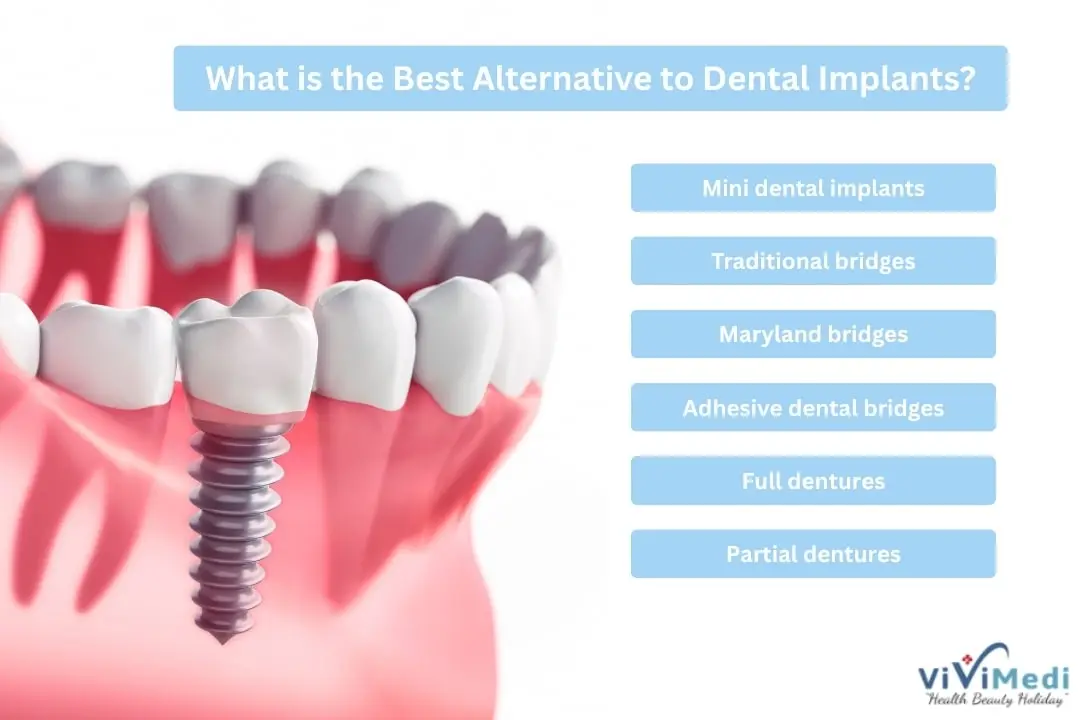What is the Best Alternative to Dental Implants?
Dental implants offer a long-lasting and natural solution for the restoration of missing teeth. However, implants may not be suitable for every individual. Cost, health conditions or fear of surgery and treatment processes may be valid reasons not to opt for dental implants. Fortunately, there are many alternatives to implants for those who have lost teeth.

In this article, we will examine treatments such as mini dental implants, dental bridges and dentures that can be alternatives to dental implants. By including information about the advantages and conditions of use of each alternative dental treatment, we will help you make the right choice in the treatment of missing teeth.
Mini implants
Mini implants are like regular dental implants but smaller. Short dental implants (< 10 mm) show similar success rates to standard implants, without major bone loss. They’re used when your jawbone isn’t thick enough for full-size implants. Advantage? Less drilling, quicker healing.
They’re mostly used to hold dentures in place or for small teeth. The process is simpler than standard procedure and often done in one visit.
Good option if you want stability but don’t want a big surgery. Just ask your dentist if they’re right for you.
Dental bridges
Have you lost a tooth? A dental bridge can fill that space like it was never gone.
It works by placing a false tooth (the bridge) between two healthy teeth. These teeth are used as support, kind of like anchors on both sides. The fake tooth sits in the middle and blends in with your smile. You don’t remove it. It’s fixed in place. You eat, talk, and smile just like before.
Are you concerned about it appearing artificial? Don’t be. A well-made bridge matches your natural teeth so well, most people won’t even notice.
Simple and strong, and it brings your bite back to normal. That’s what a dental bridge does.
Types of dental bridges
Missing a tooth? You’ve got options. Dental bridges help “bridge” the gap, and depending on where the gap is and how healthy your nearby teeth are, your dentist might pick a different style. Let’s go through them now.
Traditional bridges
These traditional bridges are perfect for you. You’ve got one or more missing teeth and strong teeth on either side? Great. The dentist shapes those side teeth and places crowns on them. Then they attach the false tooth in the middle. It’s strong, looks natural, and lasts long. You’ll probably forget it’s even there.
Does it hurt? – No, your dentist numbs you. And it’s over before you know it.
Maryland bridges
Think “glue-on” style. Instead of using full crowns, this bridge sticks to the back of your nearby teeth with little wings. No heavy drilling. Less damage to natural teeth. But it’s not as strong. That’s why dentists usually use this one for front teeth, not molars where you chew steak. Imagine a sticker instead of a full wrap. That’s basically Maryland.
Adhesive dental bridges
Kind of like Maryland, but even lighter. A fake tooth gets bonded to the back of your real teeth. Again, less drilling, more preserving your own tooth. But it’s not for everyone. If you bite hard or grind your teeth? This might not last.
Are these strong enough for everyone? – Not really. Great for front teeth, not great for heavy-duty chewing.
So, what’s right for you? – Want strength and long life? Go traditional.
Want minimal prep and it’s a front tooth? Maryland or adhesive.
Not sure? That’s what your dentist is for.
Bridges don’t just fill the gap, they give you your smile (and your chewing) back. Just pick the one that fits your life, not just your mouth.
Dentures
Let’s talk false teeth. The kind that don’t fall out when you laugh (well, not anymore). Dentures are removable teeth replacements. You use them when you’ve lost some or all of your natural teeth.
They help you eat, talk, and smile. And no, they’re not just for your grandma anymore. Today’s dentures look natural, feel better, and stay put.
Types of dentures
Not all dentures are the same. Some are for all your teeth. Others just fill in the gaps. Which one you need depends on how many teeth you’re missing and where.
Full dentures
Missing all your teeth on the top or bottom (or both)? That’s where full dentures come in. Think of them like a complete set your entire smile in one piece.
They sit on your gums and are usually held in place by suction. Sometimes people use a little denture glue too, just for extra peace of mind.
Can you eat with them? – Yes, once you get used to them!
Partial dentures
Still have some healthy teeth? Then you don’t need a full set. Partial dentures fill in just the empty spaces. They clip onto your real teeth, kind of like puzzle pieces. They’re great when you want to keep what you’ve got and just replace what’s missing. Additionally, these dentures help prevent your other teeth from shifting around.
So, which one’s better? – It’s not about better; it’s about what fits you.
All teeth missing? Go full.
Still have a few good ones? Partial’s the way to go.
Dentures don’t just fill spaces. They give you your bite, your speech, and your confidence back. And with today’s tech, no one knows you’re even wearing them.
Why are dental implants so popular?
Because dental implants work. Simple as that.
Once they’re in, you don’t even think about them. No slipping, no weird glue, no taking them out at night. Just eat, talk, smile… like you used to.
They also last a long time. We’re referring to a lifespan of over 20 years, and possibly even longer with proper care.
And let’s be honest, no one likes dealing with loose dentures or gaps in their smile. Implants fix that for good. That’s why more and more people are choosing them.
Why might I need dental implants?
If you’ve lost a tooth (or a few), that space can cause problems. Chewing gets tricky. Other teeth might shift. Even your face shape can change a little.
An implant fills the gap and keeps everything in place. It also helps protect your jawbone so it doesn’t shrink over time.
Think of it like this: if a chair leg breaks, the whole chair wobbles. That’s your smile without support. Implants are like putting the strong leg back on. Stable again.
Why Vivimedi Clinic?
Vivimedi Antalya blends top-notch dental treatments with a mini-vacation vibe.
You’ll get expert care from experienced dentists. They guide you, listen to what you want, and customize each treatment. No shortcuts!
While you recover, enjoy sunny Antalya. Walk along the sea, sip Turkish tea, and soak up the view. It’s like dental care meets a relaxing holiday.
Treat yourself, feel better, and go home smiling brighter with memories from both your teeth and your trip.
Want to chat with Vivimedi?
Contact Vivimedi dental clinic Turkey today. They’ll answer your questions and help you get started.
FAQs
What is the most affordable alternative to dental implants?
If you think implants are pricey right now, don’t worry. You still have excellent options.
The most budget-friendly solution is usually dentures. They’ve really improved in recent years. They look more natural, fit better, and are easier to wear than people think. Also, no surgery is needed. That’s a big plus.
Another choice is a dental bridge. It fills the gap by anchoring to the nearby teeth. It’s more secure than dentures and still more affordable than implants.
So, which one?
Need something fast and low-cost? Dentures.
Want something fixed but still cheaper than implants? A bridge.
But here’s the key: everyone’s mouth is different. Ask your dentist what makes the most sense for your situation. A good plan will fit your teeth, your lifestyle, and your budget.
Which dental implant alternative is the most durable and long-lasting?
If you’re not going for implants but still want something that lasts, the best pick is usually a fixed dental bridge.
Why? Because it’s attached to your own teeth. It doesn’t move. It stays in place. And with good care, it can last 10 to 15 years, sometimes even more.
Another solid option? Implant-supported dentures.
They sit on a few implants, so they’re more stable than regular ones. They’re a mix of affordability and strength.
Want something strong without going full implant?
Go with an implant-supported bridge or denture.
Can I get dental implant alternatives if I have bone loss?
Yes, you can get dental implant alternatives if you have bone loss. Bone loss doesn’t mean you’re out of options.
Dentures (especially full or partial ones) don’t need much bone to stay in place. They sit on your gums. That makes them a go-to option for people with bone loss.
Implant-supported dentures might still work too. Some clinics use special short or tilted implants for areas with less bone. Or they do bone grafting first.
But if you want to skip implants completely? Dentures or dental bridges are your best bet. No bone build-up needed. Just healthy gums and a good fit.
How long do dental implant alternatives last?
It depends on the type and how well you care for them.
- Dental bridges: usually last 10–15 years.
- Full or partial dentures: about 5–10 years (some last longer).
- Implant-supported dentures: can last 15 years or more.
But here’s the thing: the better you treat them, the longer they stay with you. Just like a car, drive it gently, and it lasts longer. Clean them, check them regularly, and avoid biting hard stuff.
What are the maintenance requirements for dental implant alternatives?
They need love, just like natural teeth.
If you have dentures, you should:
- Rinse after meals.
- Brush them daily (yes, they need brushing too).
- Soak them overnight in a cleaning solution.
- See your dentist once or twice a year for adjustments.
If you wear bridges, it’s even more important to:
- Brush twice a day
- Floss underneath the bridge using a special floss
- Avoid sticky or super hard foods
- Get regular checkups
Missed cleanings? They stain. Let food sit? Gum problems start.
The golden rule? Treat them like real teeth. Because they are your teeth now.


